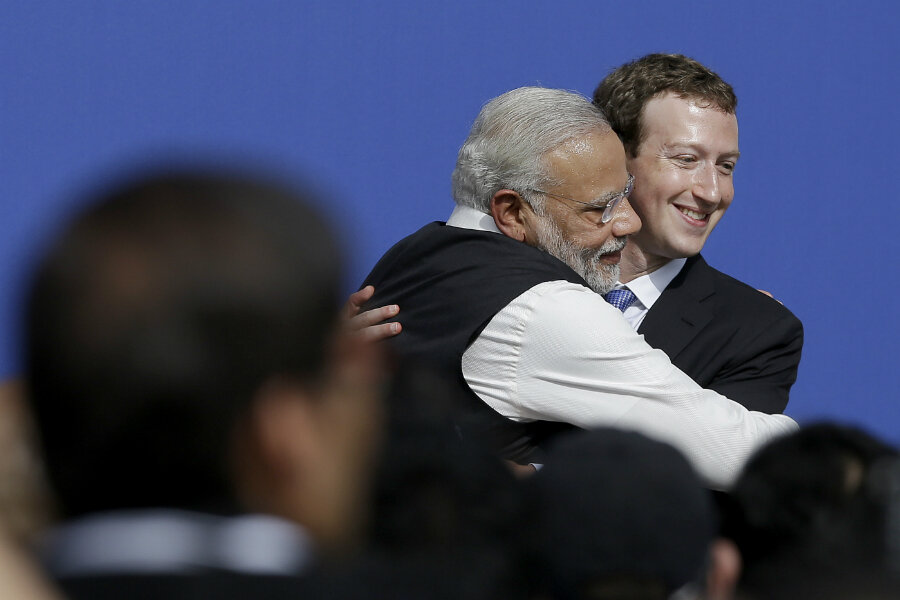Is this the era of tech diplomacy? Silicon Valley’s big week with world leaders.
Loading...
Silicon Valley took a stab at international diplomacy this past week, welcoming two major world leaders: Indian Prime Minister Narendra Modi and Chinese President Xi Jinping.
Both sought to promote and expand their tech agendas by forging relationships with influential executives and companies, placing Silicon Valley in the driver’s seat of key US interests.
But the two most populous countries in the world differ in their technology goals.
Mr. Modi aimed to build support for the Digital India initiative, a plan that calls for greatly expanding the Internet infrastructure in India’s rural areas, in addition to digitizing government services and increasing “digital literacy.” Modi believes Internet access is key to lifting people out of poverty, a belief that Facebook CEO Mark Zuckerberg conveyed during a recent speech at the UN.
Over the course of his visit, the prime minister crossed paths with executives from Microsoft, Adobe, Uber, Google, and Facebook (Mr. Zuckerberg hosted Modi at Facebook’s headquarters for a discussion and pre-screened Q&A session with employees and others invited by the Indian embassy).
And Modi did not leave empty handed: Google agreed to provide free public Wi-Fi in 500 train stations throughout India. But as The New York Times’ Vindu Goel reported, Modi’s trip was about domestic politics more than anything:
Mr. Modi’s message of partnership with American technology companies has been carefully choreographed to appeal to his constituents back in India, a country that is rapidly discovering the Internet and the start-up culture. The prime minister’s Bharatiya Janata Party has encountered setbacks in its legislative agenda and will soon face state elections.
Noticeably absent from Modi’s discussions was the issue of privacy, a significant concern in the digital era, particularly since the NSA revelations. Last month, a group of academics questioned Digital India’s motives, citing an increased capability for surveillance as a major concern:
We are concerned that the project’s potential for increased transparency in bureaucratic dealings with people is threatened by its lack of safeguards about privacy of information, and thus its potential for abuse. As it stands, “Digital India” seems to ignore key questions raised in India by critics concerned about the collection of personal information and the near certainty that such digital systems will be used to enhance surveillance and repress the constitutionally-protected rights of citizens.
Meanwhile, Mr. Xi's visit took a different tone. Issues pertaining to cybersecurity remained a top priority in light of how hacks emanating from China against US companies and government agencies have become ritualized (though they slowed ahead of Xi's visit with President Obama). As Re/code’s Noah Kulwin reported, Xi had domestic goals of his own:
Tech CEOs wanted to hear firm assurances that the Chinese government would take aggressive measures to curtail the devastating hacks that have hampered American businesses, and that their intellectual property rights would be respected. Xi wanted to assuage their fears, and also to let them know China’s recent economic struggles haven’t diminished the massive opportunity for American businesses to reach the 1.3 billion people who live there.
That last part is key. China’s massive middle-class market represents a crucial opportunity for American business, but some US companies are still barely in reach. Zuckerberg has been openly frustrated over his company’s exclusion from China, and is even learning Mandarin, partly to better understand Chinese culture, perhaps with the eventual goal of bringing his social network to the country’s nearly 600 million Internet users. But that is unlikely to happen any time soon while the government continues to censor media and block non state-sanctioned social media.
India is in a much different position. A less wealthy market where US companies face fewer barriers, India has courted philanthropic support rather than assuring business endeavors in its country would be successful – the expansion of Internet connectivity anywhere should be music to Silicon Valley’s ears.
But last week was a showcase for an emerging power in international relations that barely existed a few decades ago – and it will take a few more to know the full effect of its influence.





